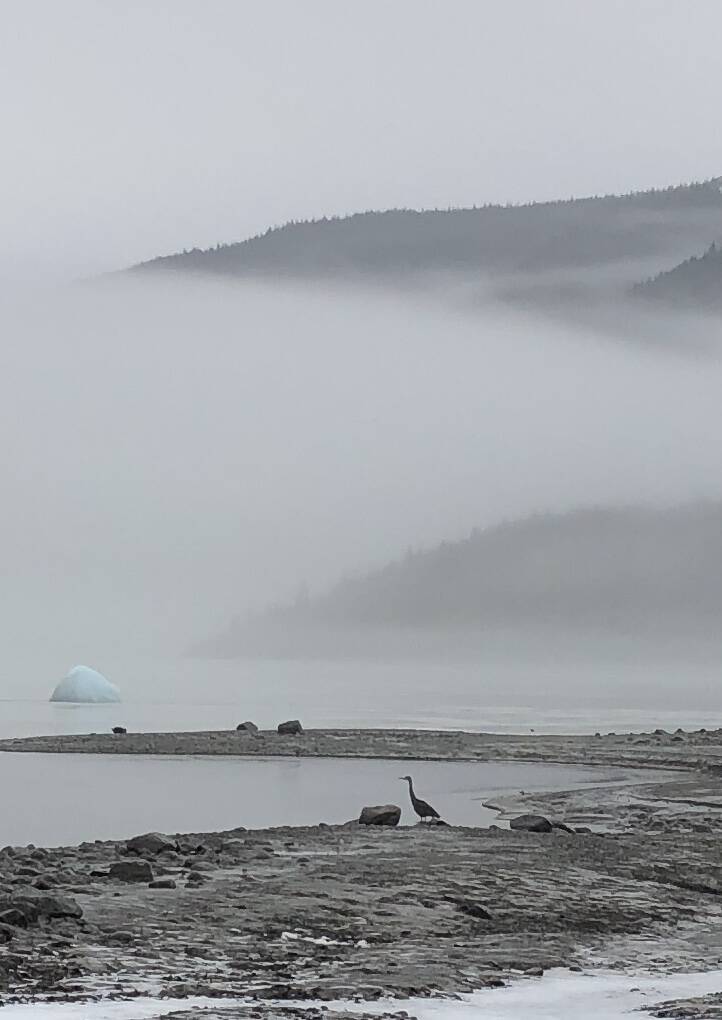A good snowfall in early November drew us out to enjoy the brightened landscape and see what we could see. Before we got very far, we crossed the trail of a very small porcupine that had traveled for many yards as if it had a known destination despite its presumed lack of experience.
Our route of choice for this first wintry walk was the beach on the west side of Mendenhall Lake., which is walkable when the water level is low. Snow clung decoratively to alder twigs and cones (and built up huge cakes under my cleats). At the upper edge of the beach, we found two big ice-boulders, presumably rounded remnants of ice bergs cast up by the jokulhlaup a couple of weeks ago.
The creeks that come down to the west side of the lake were still open and flowing, although crossing them was easy. At one creek edge, a little plaza of ice had made a dining table for mink: There were scuffle marks, a few blood stains, and lots of mink tracks. Some small fish had made that mink happy.
Then the weather changed, temperatures rose, and the rains came, destroying the lovely snow. Fog settled down over the valleys and the channel, turning the visual world into shades of gray. From the east side of Mendenhall Lake, we could see lots of recent icebergs parked partway down the lake. The blue reflections from the denser ice were the only bright spots of color visible on the landscape. An eagle hunched down, just resting, on a high cliff not far from Nugget Falls. A great blue heron stood motionless in the shallows at the edge of the lake, presumably hoping a little fish would wander by. A gray bird on a gray lakeshore with a gray and white backdrop.
On my home pond, the ice cover thinned but still supported several mallards that gobble up seeds that fall from the overhead feeder. They often rest in open water just below the dam—maybe watching that feeder for signs that the little birds are shaking out some seeds. Then they slide over the dam and hustle out to the place where seeds fall. When that is cleaned up, they march up and down the pond, to the open water at the inlet and back to the fallen-seed place. As the inflow of the stream slowly melts a channel through the ice, the ducks swim along the edges of the channel, nibbling at the edge of the ice (perhaps some edible bits are there??).
Beavers in the Dredge Lake area had been quiet, but their activity resumed with the warmer weather. A Beaver Patrol trail-cam — https://vimeo.com/771002657 — captured an adult beaver hauling branches out to its winter cache, taking time to nibble a twig, while an observant youngster watched closely. A half-culvert that had been ignored for many weeks was suddenly packed full of brush and weeds. Almost as soon as the Beaver Patrol removed all that stuff, by the next day the beavers had crammed the culvert full again. Usually, by mid-November, beaver activity has shut down for the winter, but not this year.
Freeze up from Jos Bakker on Vimeo.
The Beaver Patrol team had a treat at the Holding Pond one day; a dipper was foraging by the outflow and did not want to leave; eventually it moved across the pond to a small inflow area and foraged in the shallows. I had not seen a dipper here for a long time, although in some previous winters I could find them here fairly frequently, when the water was at least partly ice-free.
A few days later, the skies were blue, and all that sunshine required a walk that took advantage of it, so we went to Eagle Beach State Recreation Area. The brilliant sun was so low in the sky that shadows were extra-long—a small hill across the broad river cast a long shadow over the wide river and across the big meadow near the parking lot. The river had done more serious erosion of the bank by the big meadow. All the gulls were parked out on the farthest edges of the sand flats, at the water’s edge. No importunate ravens came to our picnic lunch on the beach, but the frost patterns were gorgeous. And a touch of sun-warming was welcome on a frosty day.
Walking out on the tide flats, we found lots of goose tracks and eventually saw a dozen geese resting on a distant sand bar. A big muddy channel was littered with thousands of horse clam shells; there are probably some live ones buried in that mud somewhere. In a very small muddy channel, mixed with some goose prints, there were recent tiny tracks of a shorebird (with three front toes and no hind toe), but the track-maker was not to be seen.
• Mary F. Willson is a retired professor of ecology. “On the Trails” appears every Wednesday in the Juneau Empire.

